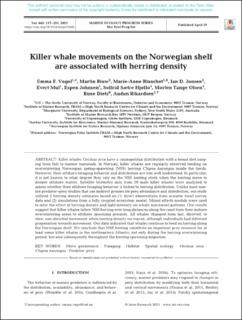| dc.contributor.author | Vogel, Emma | |
| dc.contributor.author | Biuw, Martin | |
| dc.contributor.author | Blanchet, Marie-Anne | |
| dc.contributor.author | Jonsen, Ian D. | |
| dc.contributor.author | Mul, Evert | |
| dc.contributor.author | Johnsen, Espen | |
| dc.contributor.author | Hjøllo, Solfrid Sætre | |
| dc.contributor.author | Olsen, Morten Tange | |
| dc.contributor.author | Dietz, Rune | |
| dc.contributor.author | Rikardsen, Audun | |
| dc.date.accessioned | 2023-01-05T13:41:20Z | |
| dc.date.available | 2023-01-05T13:41:20Z | |
| dc.date.created | 2021-12-10T09:44:27Z | |
| dc.date.issued | 2021 | |
| dc.identifier.uri | https://hdl.handle.net/11250/3041294 | |
| dc.description.abstract | Killer whales Orcinus orca have a cosmopolitan distribution with a broad diet rang ing from fish to marine mammals. In Norway, killer whales are regularly observed feeding on
overwintering Norwegian spring-spawning (NSS) herring Clupea harengus inside the fjords.
However, their offshore foraging behavior and distribution are less well understood. In particular,
it is not known to what degree they rely on the NSS herring stock when the herring move to
deeper offshore waters. Satellite telemetry data from 29 male killer whales were analyzed to
assess whether their offshore foraging behavior is linked to herring distribution. Unlike most mar ine predator−prey studies that use indirect proxies for prey abundance and distribution, our study
utilized 2 herring density estimates based on (1) direct observations from acoustic trawl survey
data and (2) simulations from a fully coupled ecosystem model. Mixed effects models were used
to infer the effect of herring density and light intensity on whale movement patterns. Our results
suggest that killer whales follow NSS herring over long distances along the coast from their inshore
overwintering areas to offshore spawning grounds. All whales changed from fast, directed, to
slow, non-directed movement when herring density increased, although individuals had different
propensities towards movement. Our data indicated that whales continue to feed on herring along
the Norwegian shelf. We conclude that NSS herring constitute an important prey resource for at
least some killer whales in the northeastern Atlantic, not only during the herring overwintering
period, but also subsequently throughout the herring spawning migration. | en_US |
| dc.language.iso | eng | en_US |
| dc.rights | Attribution-NonCommercial-NoDerivatives 4.0 Internasjonal | * |
| dc.rights.uri | http://creativecommons.org/licenses/by-nc-nd/4.0/deed.no | * |
| dc.subject | Move persistence | en_US |
| dc.subject | Foraging | en_US |
| dc.subject | Habitat | en_US |
| dc.subject | Spatial ecology | en_US |
| dc.subject | Orcinus orca | en_US |
| dc.subject | Clupea harengus | en_US |
| dc.subject | Predator−prey | en_US |
| dc.title | Killer whale movements on the Norwegian shelf are associated with herring density | en_US |
| dc.type | Peer reviewed | en_US |
| dc.type | Journal article | |
| dc.description.version | publishedVersion | en_US |
| dc.subject.nsi | VDP::Matematikk og Naturvitenskap: 400::Zoologiske og botaniske fag: 480 | en_US |
| dc.source.pagenumber | 217-231 | en_US |
| dc.source.volume | 665 | en_US |
| dc.source.journal | Marine Ecology Progress Series | en_US |
| dc.identifier.doi | 10.3354/meps13685 | |
| dc.identifier.cristin | 1966920 | |
| cristin.ispublished | true | |
| cristin.fulltext | original | |

